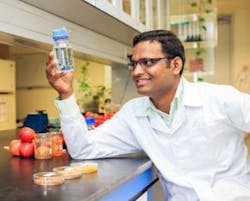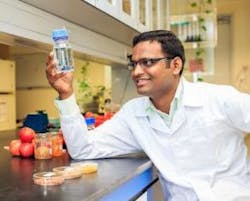July 22, 2013 -- A PhD candidate at the National University of Singapore (NUS) has discovered new methods to treat potable water using the peels of apples and tomatoes. Ramakrishna Mallampati conducted the studies under the guidance of Associate Professor Suresh Valiyaveettil of the Department of Chemistry at the NUS Faculty of Science.
The NUS team hopes that their water purification methods can benefit communities living in places where there is little electricity or resources to set up a water purification plant. This is the first time that the peels of the two fruits have been used to remove different types of pollutants in water.
Tomato peel: an efficient adsorbent for water purification
Mallampati evaluated the effectiveness of tomato peels as an adsorbent by using different pollutants. He also studied the structure of the tomato peels to assess their efficiency as biomaterials to remove toxic metal ions and organic pollutants from water. In addition, factors such as the pH, nature and amount of adsorbent used for extraction were considered to establish the optimum conditions under which tomato peels could remove various pollutants from water.
His study revealed that tomato peels can effectively remove different contaminants in water, including dissolved organic and inorganic chemicals, dyes and pesticides, and they can also be used in large scale applications. The results were published in the Royal Society of Chemistry journal "RSC Advances" in September 2012.
Apple peel: a biomass for water purification
In addition to tomato peels, Mallampati also explored the viability of using the peels of apples for water purification, as apple peels are easily available as biowaste from food processing industries and they are biodegradable.
Similar to tomato peels, apple peels can also remove a range of dissolved water pollutants through the adsorption process. In order to enhance the ability of apple peels towards extraction of negatively-charged pollutants, Mallampati immobilized naturally occurring zirconium oxides onto the surface of apple peels. Zirconium-loaded apple peels were found to be able to extract anions such as phosphate, arsenate, arsenite, and chromate ions from aqueous solutions. This method of water purification can also be used for large scale applications.
The findings are published in the American Chemical Society journal "ASC Applied Materials & Interfaces" in May 2013.
Research findings to benefit communities living in remote villages
Both Mallampati and Valiyaveettil hope that the findings on the use apple and tomato peels for water purification can benefit economically and technologically disadvantaged farmers living in remote villages, who depend on contaminated groundwater or local rivers for their daily water needs. They intend to work with non-governmental organizations to transfer their research findings and knowledge to benefit the people. The men are now looking into the use of other fruit peels and natural fibers for water purification.
###




